I’m Iowa there are five lizard species that live in the state. Iowa is also home to other reptiles like turtles, and snakes. Due to being very secretive lizards are not seen often. While you may find lizards near your home, some are not seen often. The months from spring to fall are when lizards are active most in Iowa.
Here we will take a look at the 5 lizards that live in Iowa, and the important things you should know about them. While many species may seem very similar to each other, the small differences make them unique, and also help you identify them.
Let’s take a look at the lizards in Iowa, and facts about them like how they look, where they live, and when they are most active.
Table of Contents
Lizards in Iowa
Anguidae
1. Slender Glass Lizard
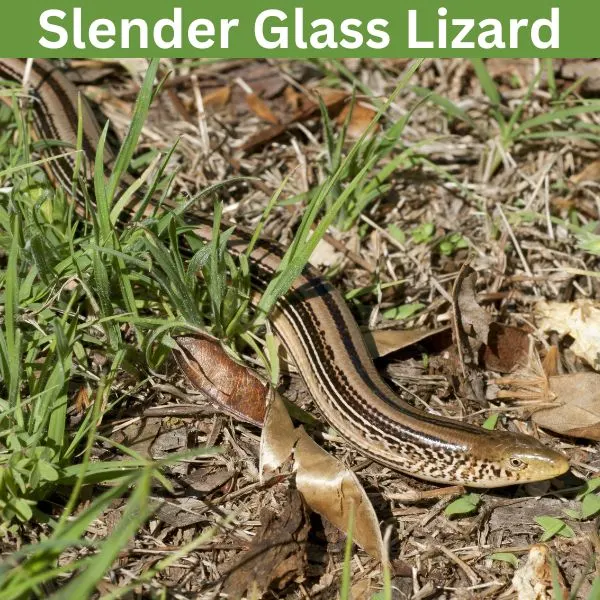
- Experience Level: Intermediate
- Family: Anguidae
- Scientific Name: Ophisaurus attenuatus
- Other Names: n/a
- Adult Size: 22 to 46 in. (55.88 to 116.84 cm.)
- Lifespan: 10 to 30 years
- Average Price Range: $50
The slender glass lizard is a legless lizard, with a body more similar to a snake. This lizard has an olive, or tan color. Their scales are smooth, and dark stripes run down their sides. Slender glass lizards are one of the largest lizards in Iowa, but look more similar to a snake. The blinkable eyelids of this lizard, and their ear holes is how you can tell they are a lizard.
Slender glass lizards are native to the eastern United States. In Iowa they are found in a small region around the southern border. Slender glass lizards live in fields, grasslands, and open habitats are where this lizard lives.
The slender glass lizard is active in the day, and hides in burrows, or under large debris. They are very rare, and their population has been affected negatively due to habitat fragmentation. This lizard is able to drop its tail, which is used to escape a predator.
Teiidae
2. Six-lined Racerunner
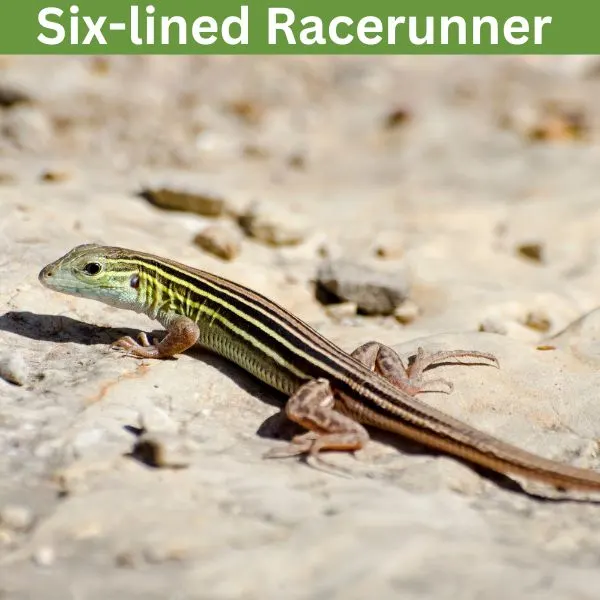
- Experience Level: Intermediate
- Family: Teiidae
- Scientific Name: Aspidoscelis sexlineata
- Other Names: Sandlapper lizard
- Adult Size: 6 to 9.5 in. (15 to 24 cm.)
- Lifespan: 4 to 5 years
- Average Price Range: $30
Six-lined racerunners are one of the fastest lizards in Iowa, and are capable of running up to 18 mph (29 kmh). These lizards are very long, and have 6 yellow, or reddish lines running down their back. Their toes are long, which help them walk in their sandy environment. This lizard has a base color that is black, olive, or tan.
Six-lined racerunners live in woodlands, grasslands, or rocky habitats. They are common near open elevations, and live in places with sandy soil. In Iowa the six-lined racerunner is found near the eastern, and western borders of the state.
Spring to fall is when this lizard is active, and they are typically seen in the day. Six-lined racerunners may hide under rocks, or in vegetation when sleeping, or during the hot part of the day. Insects, and small invertebrates make up their diet, using their speed to catch their meals.
Scincidae
3. Northern Prairie Skink
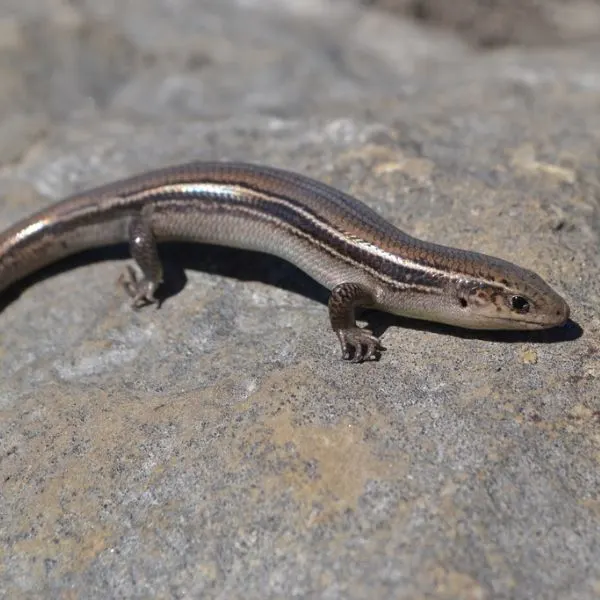
- Experience Level: Intermediate
- Family: Scincidae
- Scientific Name: Plestiodon septentrionalis
- Other Names: n/a
- Adult Size: 5 to 9 in. (13 to 22 cm.)
- Lifespan: 10 years
- Average Price Range: n/a
The prairie skink is a common lizard in Iowa, and is found in nearly all of the state. This lizard is native to the central United States. They are found in grasslands, and other open habitats near water sources. Prairie skinks are abundant, with a stable population.
These lizards are small, with tan, black, or olive coloring. They have smooth scales, with dark stripes on their sides. When born their tails are bright blue, which fade with age.
Prairie skinks sometimes burrow when resting, or when hibernating in the winter. These lizards feed on small insects, and hunt in the day. They enjoy basking in the sun, but will flee for debris if spotted.
4. Great Plains Skink
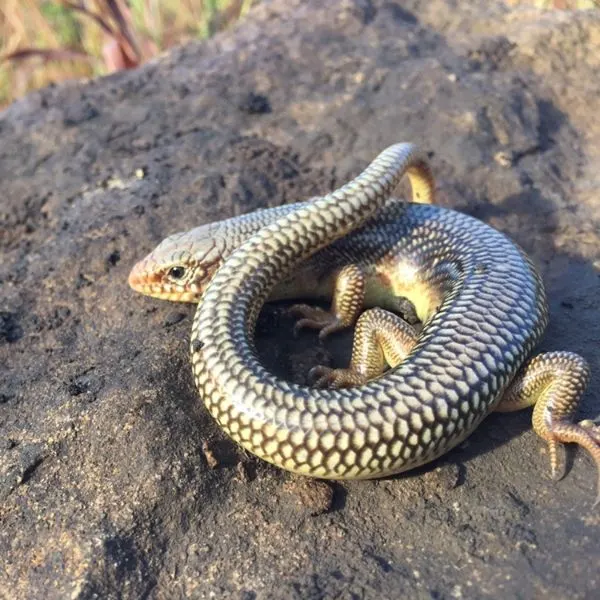
- Experience Level: Beginner
- Family: Scincidae
- Scientific Name: Plestiodon obsoletus
- Other Names: 3.5 to 5.11 in. (9 to 13 cm.)
- Adult Size: 6.5 to 13.75 in. (16.51 to 34.9 cm.)
- Lifespan: 3 years
- Average Price Range: $50
Great Plains skinks are a rare species to find in Iowa, and they have only been documented in the southwestern corner of the state. These lizards have a black, or tan coloring, with smooth scales. This species looks similar to other skinks, but does not have stripes.
This lizard is active most in spring, and lays around 5 to 32 eggs in a season. Their eggs hatch in the summer, and in winter these lizards enter brumation. Great Plains skinks when born may have black spots on them, with a blue tail.
These lizards are common, but have a small range in the United States near Texas. Great Plains skinks are a large species, and one of the biggest lizards in Iowa. Insects like grasshoppers, spiders, snails, and even other small lizards is what this species eats.
5. Common five-lined Skink
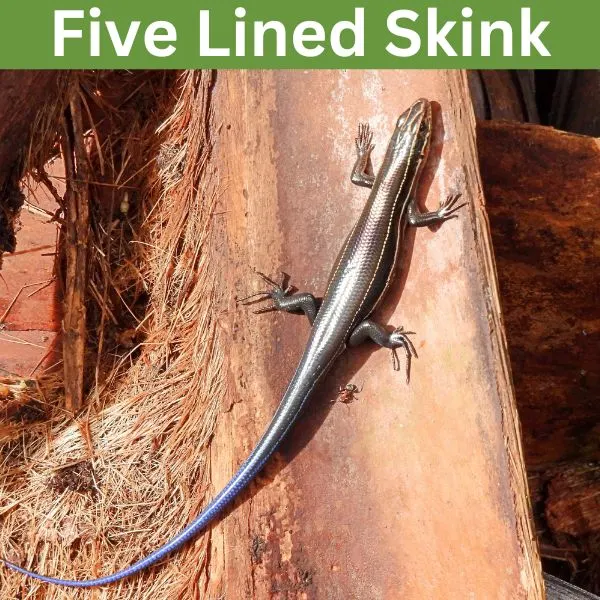
- Experience Level: Intermediate
- Family: Scincidae
- Scientific Name: Plestiodon fasciatus
- Other Names: American five-lined skink
- Adult Size: 4.9 to 8.5 in. (12.5 to 21.5 cm)
- Lifespan: 6 years
- Average Price Range: $12
The common five-lined skink is native to the eastern United States. They are found in a small region within the eastern part of Iowa. Common five-lined skinks get their name from the five lines that run down their back. They have a black, or olive coloring, with a blue tail when young.
Common five-lined skinks are found in woodlands, urban areas, grasslands, and habitats near freshwater sources. They are active in the spring and summer most, breeding, laying up to 18 eggs. Common five-lined skinks nest in moist regions that are secluded, like burrows, or under rocks.
These skinks are very aggressive in the breeding season with one another, with males becoming territorial. Small animals like frogs, smaller lizards, and insects are what this lizard eats. This lizard is common in the east, and has a stable population.
What is the most common lizard in Iowa?
The prairie skink is one of the most common lizards that lives in Iowa. Skinks are one of the most common lizards overall in the state, with around 3 species of them inhabiting Iowa. The spring to fall is when lizards are out, and active.
In Iowa what are the largest lizards in Iowa?
Slender glass lizards are a secretive lizard, and the largest that lives in Iowa. These lizards have snake-like bodies, and lack any legs, but are very robust. While they are very large these lizards’ low numbers, and tendency to burrow make them not regularly seen.
Wrapping up
In Iowa there are only 5 lizard species, but despite lizards being small, and there only being a few species, these reptiles are still an important part of the ecosystem in the state. Lizards are a valuable food source for animals like birds of prey, but are also capable of helping control the pest insect populations.
You can find several lizard species that make a good pet, but you should research them fully before committing to the animal for its lifetime. The more you learn about lizards the better chances you have at finding, and identifying them in the wild. Reptiles are amazing creatures that rely on specific environments in order to survive, which should be preserved for their population upkeep.
Other reptiles in Iowa
